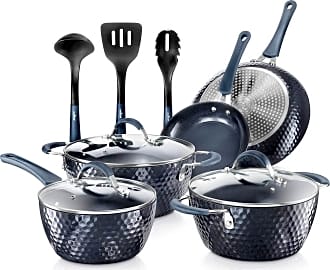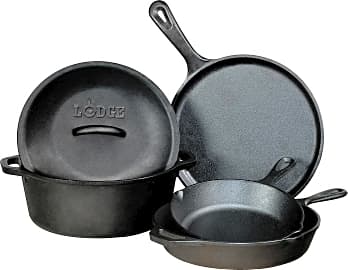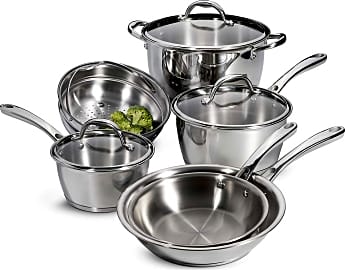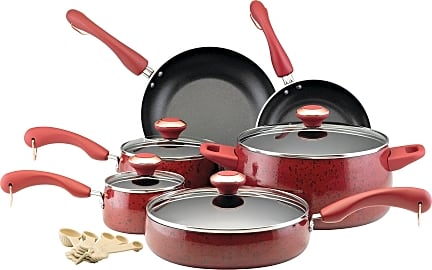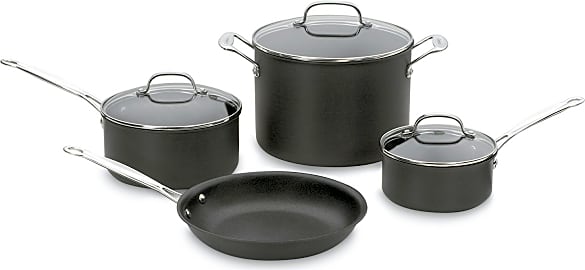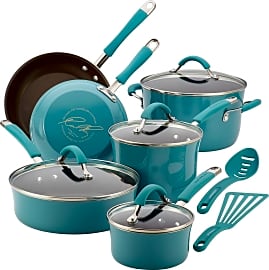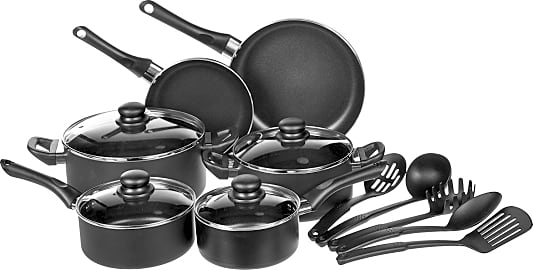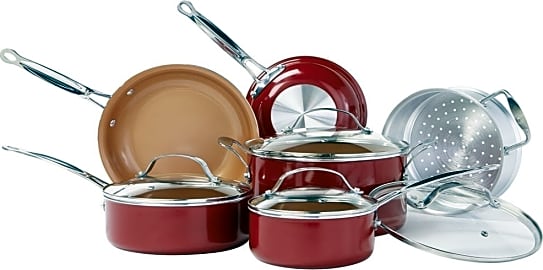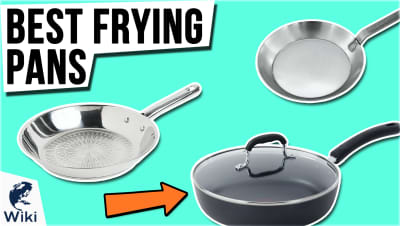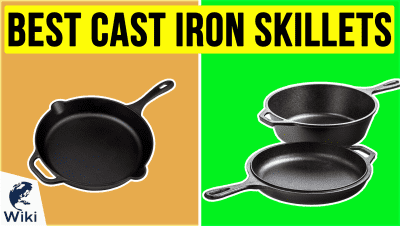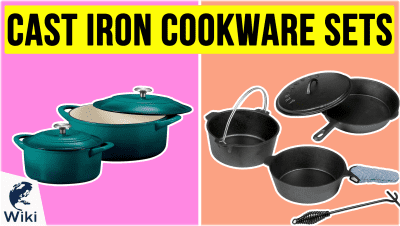The 10 Best Budget Cookware Sets

This wiki has been updated 33 times since it was first published in February of 2017. Purchasing a set of cookware can save you tons of time you'd otherwise spend painstakingly researching individual pots and pans. But these culinary essentials can also be quite pricey, which is why we found a host of budget-friendly options that can handle any recipe you turn your hand to, and they're available in a plethora of styles and colors to match any kitchen decor. When users buy our independently chosen editorial picks, we may earn commissions to help fund the Wiki.
Editor's Notes
July 25, 2020:
Coming into this update we wanted to maintain the diversity of our selections while keeping quality sets around at budget-friendly prices. We noticed that our list didn't have any cast iron options, so we added the extremely durable, American-made Lodge Cast Iron. Cast iron sets are not for the faint of heart, because they are heavy and require some special care and cleaning, however, those that know their way around this type of cookware swear by it. It lasts forever, braises and sears meats extremely well, and is rugged enough to use for campfire cookouts. The Lodge brand also comes with a silicone scraper, handle mitt, and potholder, which is a convenient touch.
We said goodbye to the GreenLife Soft Grip, as it seemed to suffer too many categorical complaints too often. Be aware, though, that no budget set is perfect and if you don't research the material and treat it properly the pieces will degrade quickly. One of the trickiest aspects to this is knowing what to cook at what heat, smoke points, and potential reactions. For example, the acidity in tomatoes and vinegar can corrode aluminum. It can feel like a burden at first, but if you do the research you'll find that your set, especially the frying pans, will last a long time.
Also joining the ranks today is the NutriChef Excilon, which utilizes a ceramic coating for its nonstick properties. The pieces feature a clever five-layer construction and are nontoxic, easy to clean, and attractive with their diamond-like pattern. The lids are vented, see-through, and tempered, and the entire thing is backed by a ten-year warranty. Another nice thing about this option, as with a few others on this list, is the inclusion of items you wouldn't normally expect, like serving utensils, fish spatulas, steamers, colanders, and more.
June 04, 2019:
With handy heat indicators, the T-fal Thermo-Spot lets you know when your pots and pans are preheated to 350°F. Their anti-warp bases and hard anodized exteriors make them durable and resistant to scratching, and they can stand up to metal utensils and the heat of the dishwasher. The Cuisinart Chef's Classic is a basic set that consists of a 10-inch skillet, two saucepans, and an 8-quart stockpot. Each one has a titanium-reinforced nonstick coating, a tapered rim for drip-free pouring, and strong, riveted handles. Thanks to built-in pour spouts and lids that double as colanders, the WearEver Cook and Strain make it easy to drain away excess liquid and oils. They're oven-safe up to 500°F, and the interiors are designed to be easy to clean. With their heavy-duty construction and shatter-resistant lids, the Paula Deen Signature can stand up to frequent use. The porcelain enamel exteriors come in six colors with a speckled finish and are resistant to stains. The AmazonBasics 15-Piece is a great set for cooks who are just getting started. It comes with two saucepans, two casserole pans, two skillets, and five utensils. However, the pots are a bit on the small side, so it's probably not the best choice for big families.
Special Honors
Cook Pro Inc. Copper 546 This eight-piece, triple-ply set consists of the basics in an elegant copper shade with a mirror-polished finish. Each piece sports long riveted stainless steel cast handles for easy handling and tempered, vented glass so you can monitor your food. The heavy-duty construction should last some time, and the set is oven and dishwasher safe, PFOA and PTFE free, and stackable. cookpro.com
Piral Terracotta Cookware Home cooks looking for unique, versatile, hardwearing pieces made with expertise and care should consider curating a set from the offerings at Terra Allegra. This Italian company provides extremely well-constructed and attractive cookware at a fraction of the price many other artisanal storefronts do. These items are easy to clean, lightweight, and energy-efficient and sport a glass-like finish that seals the clay interior to maintain the integrity of your food. Choose from saute pans, crocks, Dutch ovens, saucepans, stockpots, and more. terraallegra.com
How To Choose The Best Cookware Set For You
It's extremely durable and nonreactive, meaning you can cook anything in it with no residual flavors or odors.
If you're looking to buy your very first cookware set, the sheer number of choices available can make your head spin. There are so many shapes, sizes, and materials that making a decision can seem overwhelming. But the most important thing to note right off the bat is that you don't have to spend half a paycheck to get a set that will suit your needs. There are excellent options at many price points, so we'll start by going over what you should look for in a cookware set, depending on your individual preferences and cooking habits.
Stainless steel is great for high-heat applications, like searing a steak or cooking under a broiler. It's extremely durable and nonreactive, meaning you can cook anything in it with no residual flavors or odors. However, it doesn't distribute heat as evenly as some other materials, and inexperienced cooks may find it difficult to cook eggs and other foods that tend to stick to pans easily.
Aluminum is lightweight and typically inexpensive. It conducts heat very well, so it heats up faster than most other materials. On the other hand, it's a softer metal that scratches and dents more easily than stainless steel, and it's reactive with tomatoes, vinegar, and other acidic foods.
Nonstick pans are great for beginners as they're more forgiving when cooking delicate dishes like pancakes or omelettes. Most foods release easily, leaving very little residue behind, making Teflon and other nonstick surfaces a breeze to clean. On the downside, though, they can't handle super high heats, and many of them are not safe for use in the oven.
How To Care for Different Types Of Cookware
Depending on what they're made of, different types of pots and pans can require a very different care regimen.
First off — and please don't be mad at us for this — no matter what type of cookware you have, it will last longer if you wash it by hand rather than in the dishwasher. And if you're on a tight budget, you want your kitchen gear to last as long as possible. Even if pots and pans claim to be dishwasher-safe, the high heat and abrasive cleaners can be damaging, especially for nonstick coatings. But, if you absolutely must use the dishwasher, try to find the gentlest detergent possible and don't use the super hot cycle.
Depending on what they're made of, different types of pots and pans can require a very different care regimen.
Nonstick cookware is probably the easiest to take care of since, as the name implies, food doesn't typically stick to it. A sponge or washcloth with some plain old dish soap is your best bet, but you can also use a paste of baking soda and water, as long as you don't scrub too hard. It's best not to use cooking sprays on nonstick cookware if you can avoid it — they can be harder to wash off and the buildup can make your pans sticky.
For stainless steel, steer clear of abrasive cleaners and sponges, as they may scratch the surface. Dry your pans inside and out as soon as you finish washing them to avoid water spots. For burnt-on food or discolored areas, Bar Keepers Friend is, well, your best friend. This inexpensive powdered cleanser will remove stains and leave your cookware looking brand new. But, if you don't have any, you can boil some water and vinegar, or make a scrub from baking soda instead.
Cast iron is one of the best materials out there for braising, searing, and making homemade pizzas, but it is rather finicky when it comes to cleaning. It's okay to use a little bit of mild dish soap once your pan is well-seasoned, but while you're still building up your seasoning, it's best to forego the suds. You can use hot water and a stiff brush, but steer clear of steel wool as it may damage your seasoning. For tough, cooked-on bits, you can scrub the pan with kosher salt and water, then rinse or wipe it clean with a paper towel. It's important to thoroughly dry cast iron after washing, and to keep your seasoning looking good, heat it up in the oven or on the stovetop and rub it with a thin coat of oil after each use.
A Brief History Of Cookware
While the origins of the very first piece of cookware are unknown, modern-day pots and pans are a far cry from the humble pottery vessels used in ancient days to roast food over a fire. Early boiling methods included using rocks from hot springs to raise the water temperature, and some of the first waterproof cookware was made from turtle shells or carved from rocks.
The coals would harden the clay, allowing it to separate from the basket to become its own cooking vessel.
Native Americans started out using woven baskets for their cooking, and formed special waterproof baskets out of leaves. They made roasting pans by covering a basket with clay and filling it with wood coals. The coals would harden the clay, allowing it to separate from the basket to become its own cooking vessel.
Centuries later, advancements in metalworking led to the creation of the first metal cookware, but it was extremely expensive, so many Medieval kitchens still used clay pots for most of their cooking. It wasn't until the 17th century that iron, brass, and copper began to be used extensively in cookware. Today, stainless steel and aluminum are the most common types of metals used in pots and pans.
Cast iron, the original nonstick material, may be making a comeback, but you're far more likely to find Teflon or ceramic-coated skillets in the average kitchen. It seems like a modern-day convenience, but Teflon was actually discovered — by accident — in 1938 by a scientist named Roy J. Plunkett, who was working in one of DuPont's research laboratories. At first, it seemed that it was too expensive to manufacture for the company to ever find a market for it, and it took years for Teflon-coated pots and pans to be invented. Dr. Plunkett won Philadelphia’s Scott Medal in 1951 for his discovery, and Teflon bakeware was formally introduced to the public by giving each person who attended the banquet a nonstick muffin pan.



